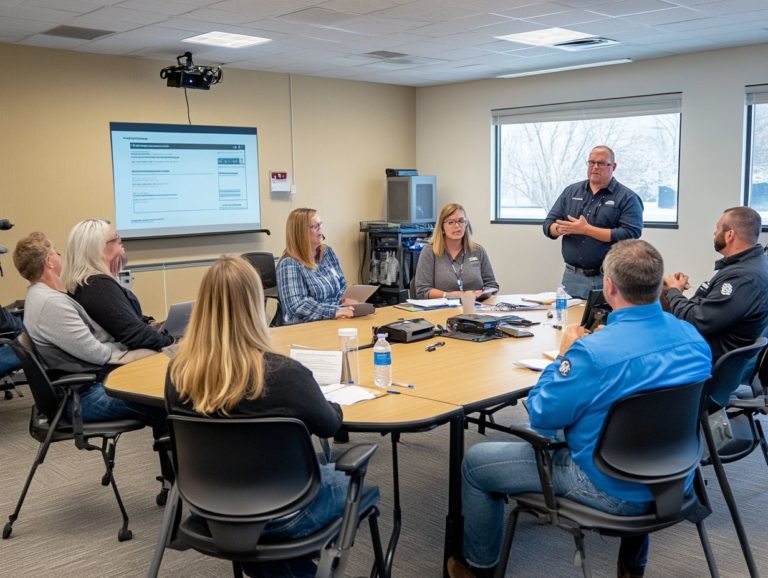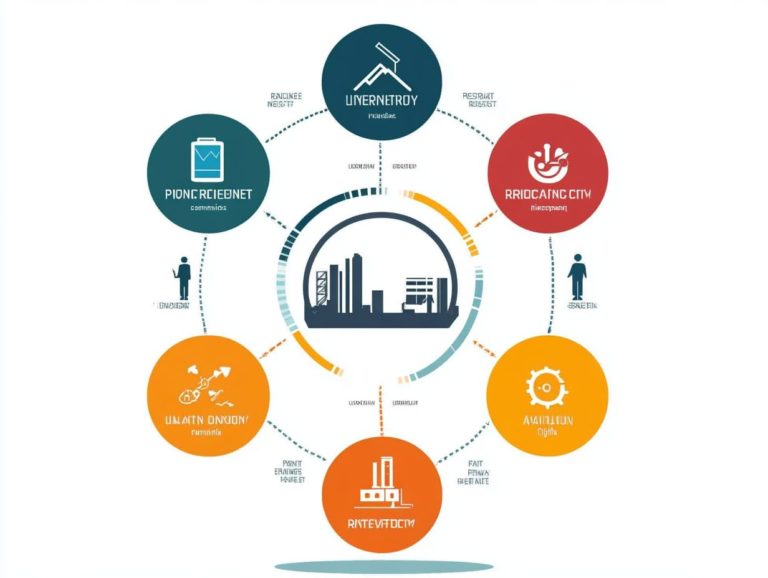5 tools for automating incident response
In today s fast-paced threat landscape, you must stay ahead of cyber threats to safeguard your assets and data. This article covers five essential tools for automating incident response, including Security Information and Event Management (SIEM) solutions and Endpoint Detection and Response (EDR) technologies.
You ll discover how automation streamlines security processes. Enhance your organization s resilience against cyber incidents effectively!
Contents
- Key Takeaways:
- 1. Security Information and Event Management (SIEM) Tools
- 2. Security Orchestration, Automation, and Response (SOAR) Platforms
- 3. Threat Intelligence Platforms
- 4. Incident Response Automation Tools
- 5. Endpoint Detection and Response (EDR) Solutions
- What Is Incident Response and Why Is Automation Important?
- What Are the Key Features to Look for in an Incident Response Automation Tool?
- How Can Automation Improve Incident Response Processes?
- What Are the Potential Risks and Challenges of Automating Incident Response?
- How Can Organizations Implement Automation in Their Incident Response Plan?
- What Are the Future Trends in Incident Response Automation?
- Frequently Asked Questions
- What are five tools for automating incident response?
- How can SIEM help with automating incident response?
- What is the role of SAO in automating incident response?
- How does IRA contribute to automating incident response?
- Why are TIPs important for automating incident response?
- What are the benefits of using SOAR for automating incident response?
Key Takeaways:

SIEM tools monitor and analyze security events, enabling real-time threat detection and response. SOAR platforms integrate multiple security tools and automate incident response tasks for improved efficiency.
Incident response automation tools leverage AI and machine learning to quickly detect and respond to security incidents, minimizing human error.
1. Security Information and Event Management (SIEM) Tools
SIEM tools are vital for incident management. They empower you to monitor, analyze, and respond swiftly to disruptions while receiving automated notifications.
These tools aggregate data from various sources, allowing real-time tracking of events. This capability aids in identifying anomalies and pinpointing the source of issues.
Customize alerts based on threat levels to ensure critical incidents receive prompt attention. Their integration with other systems streamlines workflows and enhances response times.
2. Security Orchestration, Automation, and Response (SOAR) Platforms
SOAR platforms integrate various incident management tools for a sophisticated incident response. They automate routine tasks, significantly boosting efficiency and reducing human error.
Popular SOAR platforms like Palo Alto Networks’ Cortex XSOAR and Splunk Phantom can accelerate incident resolution. These systems help build a cohesive security posture.
3. Threat Intelligence Platforms
Threat intelligence platforms enhance your incident response by providing essential data. They help you anticipate and mitigate threats through timely notifications.
These systems gather and analyze data from various sources. By leveraging this information, your team can identify emerging threats in real-time.
This proactive approach streamlines decision-making and fosters a culture of preparedness. Equip your organization to tackle cyber challenges effectively!
4. Incident Response Automation Tools

Incident response automation tools are essential for streamlining incident management processes. By automating routine tasks, enhancing incident ticketing systems, and providing timely automated notifications, these tools significantly accelerate response times during critical situations.
These solutions alleviate the manual workload on your IT teams, allowing them to concentrate on strategic initiatives instead of getting bogged down in repetitive tasks. A standout feature is their ability to integrate seamlessly with your existing systems, ensuring a fluid workflow across various platforms.
Most of these tools are designed with user-friendliness in mind, so even team members with minimal technical expertise can navigate them with ease. Popular options on the market include:
- Splunk Phantom
- ServiceNow
- IBM Resilient
These tools offer customizable dashboards and analytics, empowering your teams to respond more effectively to emerging threats and enhancing your overall cybersecurity posture.
5. Endpoint Detection and Response (EDR) Solutions
Endpoint Detection and Response (EDR) solutions are essential in the realm of incident response. They offer real-time performance monitoring and analytics, enabling your organization to swiftly identify and address unforeseen disruptions with the expertise of skilled technicians.
These solutions keep a sharp eye on endpoints, continuously scanning for suspicious activities or potential threats. This proactive approach ensures that any anomalies are detected at the earliest possible stage.
The significance of EDR in incident management is profound. By streamlining threat detection and facilitating automated responses, these solutions considerably shorten the time required to mitigate risks.
Their features, ranging from monitoring user behavior to automated remediation and detailed reports, enhance your security capabilities. This enables your cybersecurity teams to make informed decisions with impressive speed.
Integrating threat intelligence feeds helps your organization stay ahead of emerging threats, bolstering defenses while minimizing the impact of any incidents that may arise.
What Is Incident Response and Why Is Automation Important?
Incident response is your systematic approach to managing unexpected disruptions in IT systems. Automation is vital as it significantly boosts the efficiency and effectiveness of your incident management, enabling your team to respond swiftly and minimize potential damages.
A well-defined incident response process involves several key stages:
- Preparation
- Detection
- Analysis
- Containment
- Eradication
- Recovery
- Post-incident review
By harnessing the power of automation, you can streamline tasks like alert tracking and incident documentation, ensuring that crucial information is readily available for in-depth analysis.
Integrating automated tools not only accelerates your incident response but also reduces the chance of human error, resulting in greater accuracy in problem resolution. As a result, you ll notice a decrease in downtime and an improvement in overall service status, ultimately fostering greater customer trust and satisfaction.
What Are the Key Features to Look for in an Incident Response Automation Tool?
When selecting an incident response automation tool, prioritize key features such as robust incident tracking software, customizable alerting options, and seamless integration with your existing systems. For an in-depth look at the top 5 incident response tools for 2024, these elements are crucial for effective incident management.
Beyond these core functionalities, a user-friendly interface can significantly elevate the experience for your teams engaged in incident resolution. Tools with intuitive dashboards enable you to access critical information swiftly, improving response times.
Detailed reports are essential, allowing you to analyze trends and identify recurring issues. This aligns perfectly with ITIL procedures for continual service improvement.
By adopting a proactive approach to incident management, these features empower you to streamline processes and foster better collaboration among your IT staff.
How Can Automation Improve Incident Response Processes?

Automation can significantly enhance your incident response processes by boosting efficiency and cutting down response times. It also frees your IT department to concentrate on high-priority tasks while using incident management tools to monitor performance.
Automated notifications can quickly alert your team about critical service disruptions, so everyone can act fast. This ensures that everyone is in the loop and ready to act quickly.
Ticketing systems that automate the logging and categorization of incidents empower your teams to prioritize issues based on severity. This streamlines the resolution process.
By adopting these solutions, your organization not only elevates its operational agility but also creates a proactive culture that tackles problems early. This ultimately enhances user satisfaction and system reliability.
What Are the Potential Risks and Challenges of Automating Incident Response?
Automation in incident response offers many benefits, but it also poses certain risks and challenges. You may find yourself overly reliant on technology, which underscores the importance of ongoing technician expertise to manage and optimize automated systems effectively.
As you attempt to embed automation into your existing workflows, integration issues may arise. This can potentially lead to fragmented processes and inefficiencies.
The importance of staff training cannot be overstated. Without proper education, your team might struggle to utilize automated systems to their fullest potential.
To address these risks, it s crucial to develop a comprehensive training program and ensure seamless integration with your existing tools. Collaboration between IT and operations is key! It can turn automation into your best ally.
How Can Organizations Implement Automation in Their Incident Response Plan?
You can enhance your incident response plan by implementing automation through the careful selection of incident management tools that boast robust automation features. To learn more about these tools, check out our guide on common incident response tools explained. Start with a free trial to gauge their compatibility and effectiveness within your existing frameworks.
After evaluating your initial options, conduct a thorough assessment of your current processes. Identify repetitive tasks that stand to benefit from automation and prioritize them based on their potential impact.
Once you ve established suitability, choosing the right tools becomes crucial for seamless integration. Focus on comprehensive training for your staff, equipping them with the knowledge needed to use these tools effectively.
By following these steps, you can maximize the benefits of automation, leading to more efficient incident management and significantly improved overall responses.
What Are the Future Trends in Incident Response Automation?
The future of incident response automation is on the brink of remarkable advancements. This is driven by emerging trends like the integration of AI technologies, improved incident tracking software, and the rising adoption of SaaS solutions that streamline incident management processes.
As you navigate this evolving landscape, invest in cutting-edge tools and cultivate a culture of collaboration among your teams. Establishing clear protocols for information sharing and decision-making will significantly enhance your ability to respond swiftly to incidents.
Upskilling your personnel to effectively utilize these automated systems will be essential. This ensures that human oversight complements technological capabilities.
By keeping an eye on future trends, you can prepare your organization to take advantage of new innovations that will strengthen your incident response frameworks and ultimately bolster your resilience against potential threats.
Frequently Asked Questions

What are five tools for automating incident response?
Here are five tools for automating incident response:
- Security Information and Event Management (SIEM)
- Security Automation and Orchestration (SAO)
- Incident Response Automation (IRA)
- Threat Intelligence Platforms (TIPs)
- Security Orchestration, Automation, and Response (SOAR)
How can SIEM help with automating incident response?
SIEM helps automate incident response by bringing together security event data from various sources.
It provides real-time monitoring, alerting capabilities, and allows for automated responses based on pre-defined rules and policies.
What is the role of SAO in automating incident response?
SAO streamlines and orchestrates various security processes and tools within an organization.
This reduces response times and minimizes manual tasks for security teams.
How does IRA contribute to automating incident response?
IRA uses automated workflows and playbooks to guide the response process.
This enables faster, more efficient incident resolution and frees up human resources for critical tasks.
Why are TIPs important for automating incident response?
TIPs are crucial for automating incident response and can make your security efforts much more effective!
They provide access to real-time threat intelligence data to automatically identify and respond to potential security threats.
What are the benefits of using SOAR for automating incident response?
SOAR provides several benefits, including automated incident triage and prioritization.
It integrates with multiple security tools and processes and tracks incident response metrics for continuous improvement.
Using these tools can drastically reduce your organization’s risk of security incidents. Don t wait implement them now!






